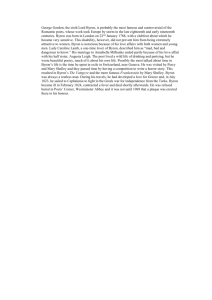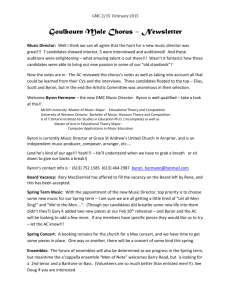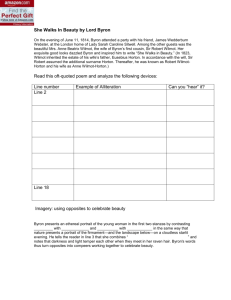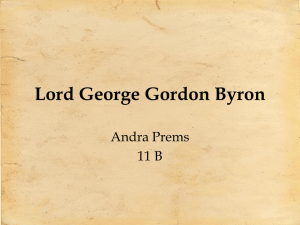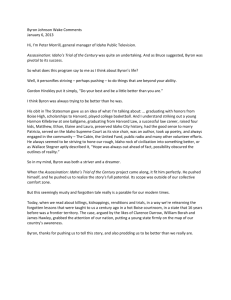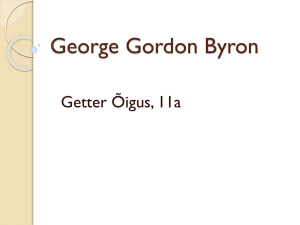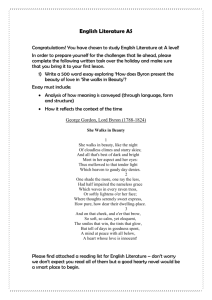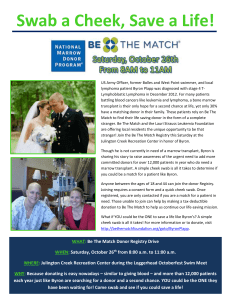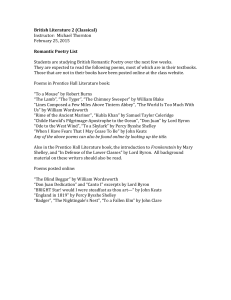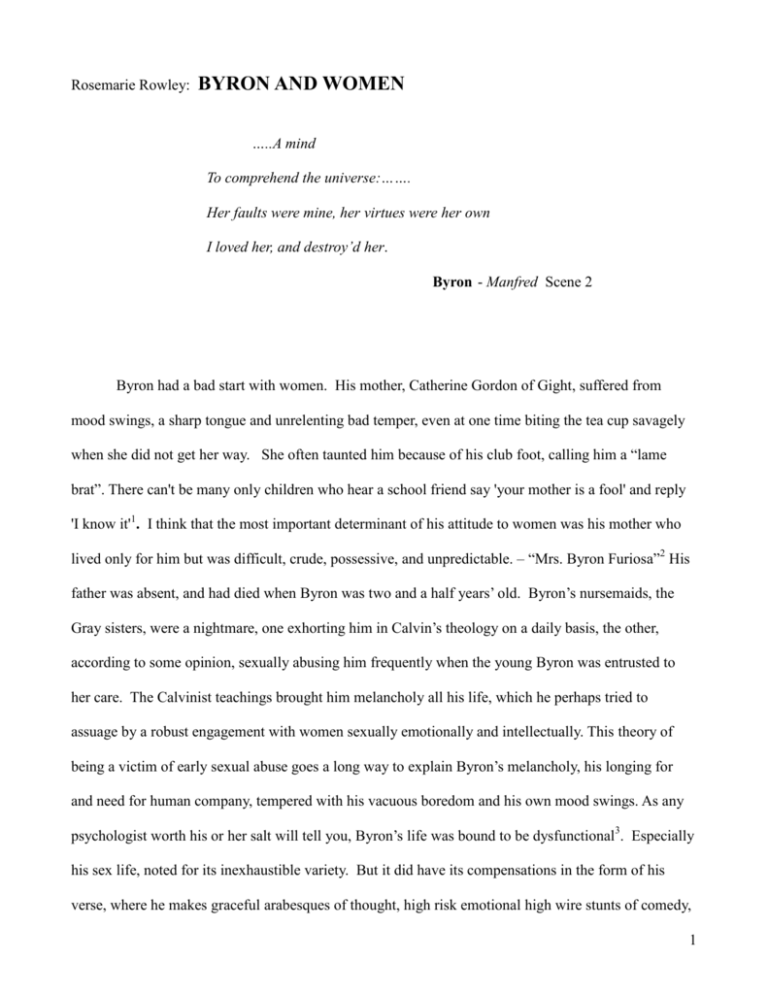
Rosemarie Rowley:
BYRON AND WOMEN
…..A mind
To comprehend the universe:…….
Her faults were mine, her virtues were her own
I loved her, and destroy’d her.
Byron - Manfred Scene 2
Byron had a bad start with women. His mother, Catherine Gordon of Gight, suffered from
mood swings, a sharp tongue and unrelenting bad temper, even at one time biting the tea cup savagely
when she did not get her way. She often taunted him because of his club foot, calling him a “lame
brat”. There can't be many only children who hear a school friend say 'your mother is a fool' and reply
'I know it'1. I think that the most important determinant of his attitude to women was his mother who
lived only for him but was difficult, crude, possessive, and unpredictable. – “Mrs. Byron Furiosa”2 His
father was absent, and had died when Byron was two and a half years’ old. Byron’s nursemaids, the
Gray sisters, were a nightmare, one exhorting him in Calvin’s theology on a daily basis, the other,
according to some opinion, sexually abusing him frequently when the young Byron was entrusted to
her care. The Calvinist teachings brought him melancholy all his life, which he perhaps tried to
assuage by a robust engagement with women sexually emotionally and intellectually. This theory of
being a victim of early sexual abuse goes a long way to explain Byron’s melancholy, his longing for
and need for human company, tempered with his vacuous boredom and his own mood swings. As any
psychologist worth his or her salt will tell you, Byron’s life was bound to be dysfunctional3. Especially
his sex life, noted for its inexhaustible variety. But it did have its compensations in the form of his
verse, where he makes graceful arabesques of thought, high risk emotional high wire stunts of comedy,
1
parody and witty burlesques.
There is a view of Byron, as a gay icon, only interested in men, which has dominated the Byron
discourse of our day, most notably in the 2002 biography by Fiona McCarthy, and more recently, (July
26 and August 2, 2009) in Channel 4’s “The Scandalous Adventures of Byron”. From the presenter,
Rupert Everett’s point of view, Byron not only disliked women, but all his relationships with them were
somehow false, unreal, and unimportant.
We could ask, from the evidence we have, whether Byron was also attracted to women, or was
bisexual, and had important relationships with both sexes. Of course, it is difficult to go back a couple
of hundred years with a modern agenda, but that is what is happening to reputations in our day, which
indeed is a celebrity culture, with the lowest common denominator to the fore. So this paper looks on
the question from another point of view – balance.
We know from the evidence that Byron liked women, and the wonder is, with such a difficult
mother, that he liked women at all – yet his life history is peppered with encounters, friendships,
romantic love and sexual amours with women so numerous that they are beyond counting. So far from
being a misogynist, and predominantly homosexual as Fiona McCarthy has argued in her biography
“Byron: Life and Legend," Byron sought to find fulfillment through all the permutations and vagaries
with the opposite sex, as lover and friend.
If we on the other hand, could accuse Byron of the 20th century sin of sexism, we find no
evidence that Byron was essentially against the idea of women, particularly against the education and
liberation of women, to label him sexist. But did he take on women as his equals? This would be a
very unusual notion in his day, or otherwise Mary Wollstonecraft would not have presumed a surprised
and unconvinced readership for her Vindication of the Rights of Woman to evidence this point.
We will begin with Byron as a love poet. As Margaret Drabble, the novelist, observes,
“Libertines write the best love songs – Byron or Burns, those faithless lovers and shameless
womanizers have long been recognized as problematic figures by female critics.”4
2
But as to whether Bryon really liked women, would we judge a male poet these days on how he
was on the question of equality for women? Some women writers have. Romance and equality do not
always go hand in hand. It is unlikely that Byron would not begin where most modern people begin –
with an assumption that equality is a necessary and primary value in politics or in relationships.
However, his attitude to others was humanitarian, approaching egalitarian – he was affectionate with
his servants and loved by them5, paying an allowance for a baby whose mother was a servant and
which might have been his, and in another case, paying release from conscription in Venice. His first
speech in the House of Lords, on the frame breakers and the threat to livelihoods, showed that he had
ideals for justice uncommon for his aristocratic background, However, love, justice and equality do not
always go hand in hand, even in our political correct era. But certainly there is evidence that he strived
to be just to others, including women.
Bernard Beatty, in correspondence with the author of this paper, makes the point that equality
with women did not really exist in Regency England (half a century later both Tennyson and Gilbert
and Sullivan take for granted that they can get a laugh out of the idea of women at university, and this
laugh would be shared by a lot of women)—“so almost everyone in regency England except selfconscious feminists like Shelley (but not his wife Mary, who was suspicious of progress) and Mary
Wollstonecraft—would be regarded as sexist by us.”
One of the things that is obvious and most interesting about Byron is his awareness of the
contradictoriness of human behaviour and understanding (why he admired Pope and Montaigne who
also insisted on this). So what seems more interesting is not whether we can or cannot tick the box
'misogynist' or 'feminist' for Byron as though the label would catch him—to try to do this would be to
think in a very un-Byronic way—but rather catch or try to catch the interrelations between different
attitudes. Thus Byron often mocks the idea and fact of intellectual women -blue-stockings—in the
Blues and the Waltz, portraits of his wife, praise of harem societies, for example.
3
So it is not straightforward at all. If Byron at times despised intellectual women and liked
'female animals' like Margarita Cogni, in crucial matters actually sought out intellectual women as his
closest confidantes, and friends. He married Annabella, a gifted mathematician (but not emotionally
intelligent). His first important relationship with a woman was with Lady Caroline Lamb, who played
intellectual games and dressed up in her pageboy’s uniforms. At the end of his life, his most sustained
relationship was with a woman scholar, Teresa Guiccioli . He also read and admired female writers
(Joanna Baillie, Mme de Stael). So it this sense, he liked relationships with women which approached
intellectual equality, though at times he varied in his treatment of women. What he did was to react
with and against them, so they are not the passive heroines of popular culture but women gifted with
spirit and imagination. In our age of political correctness, when equality has been confused with the
idea of being identical, we may find it hard to understand the complexity of relationships in a previous
age which itself had traditions and antecedents as well as contemporary trends.
Byron was born at a propitious time for intellectual men, in the very eve of the greatest social
revolution the world had known, the French Revolution, famous for its thinkers, and its activists, and
came of age at a time of great political ferment, when these extreme ideas had been tested and tried,
leading to new solutions of age-old inequalities, the ideas of brotherhood and equality for men – but
not explicitly, for women. Byron seems ambiguous about these new developments in general, and as
regards women and equality, he grew up in an age which had honoured in its recent past the
intellectual qualities of women, namely the Blue Stocking movement. This movement to do with the
emancipation of women had already taken place in the half century before the French revolution, and
before Byron was born, and that many of the women he met while a young man in England were
accomplished, widely read, and intellectually adventurous6.
However, because the movement was not organized along political lines, it was moribund by
the time of Wollstonecraft’s Vindication, .which book really did not have its apogee until the final
4
decades of the 20th century. Wollstonecraft proposed the deliberate extrapolation of Enlightenment
ideals to include education for women, whose rational natures she believed were no less capable of
intellectual pursuits than those of men. This appeal to reason seems to have been a reaction to the overt
feminism of the 18th century which emphasized sensibility and made women a universal model.
Women were now looking to men as role models. The Della Cruscans, who praised exaggerated
sensibility and were thought feminine, considered themselves as intellectuals as well. Commentators
are familiar with arguments that the 18th century sees a steady increase in the feminization of women
and their association overwhelmingly with sensibility which reversed what happened in the 17th century
when women (see Restoration comedy) were more mannish in wit and overtly sexual. So what is the
true sounding board? Often these changes were brought about by novel reading, particularly since
social mobility was on the rise, and the middle classes were being absorbed in some measure into the
aristocracy. Reading novels pushed away social barriers and distinctions by making them imaginative,
and thus able to be played upon both by writers and their readers. By the middle of the 18th century
women themselves became authors on a grand scale, mostly of novels, and by the time of Jane Austen,
who wrote her novels while Byron published his poetry, relations between the sexes were the subject of
much discourse, Sense and Sensibility being a very typical example of this fluidity, which existed
alongside extreme courtesy and harsh economic reality – women as yet could not earn their own living.
The Della Cruscans were notorious for having an exaggerated form of sensibility which played up the
supposedly feminine characteristics such as copious weeping – so Byron’s masculine persona and
Austen’s irony were a reflection of what was an extremely complex and interesting time for both men
and women. Byron had no time for the stereotypes of the day and attacked the Della Cruscans in
“English Bards and Scotch reviewers”, even though some commentators, such as McGann7, on Byron’s
early poetry criticize it for this very reason.
So this brings us to the essential quality of Byron’s poetry, that in his mind he held two
contrarieties, and his work was in dialogue with those movements of the day, but more particularly not
5
with abstractions but the human qualities of both his protagonists and his readers.
Though he engaged on the intellectual level with many women, our own culture today,
particularly feminism, finds it problematic that relations between the sexes are indeed more complex
than the politically correct view. To go back to the mother of feminism, Mary Wollstonecraft, her
campaign for women as being as rational as men was fundamental to her philosophy and her work yet
Mary Wollstonecraft ended up yielding to social pressure by marrying William Godwin,
Byron also exemplifies a paradox of our age: that it, it simultaneously celebrates love and
romance while castigating its proponents in the lurid popular press: indeed our age is the age of the
double think. It is remarkable that it is Western democratic culture that is exhibiting this feature rather
than the socialist countries which Orwell was writing about in 1984. Along with the cult of celebrity,
its aim is to dumb down and simplify.
Our age portrays women as free, touting female achievement and independence, while society
does not help them to realize their biological destinies due to difficult conditions for mothers in the
workplace. Recently the “Observer” (August 9, 2009) newspaper ran a feature focusing on this aspect
of women and fertility. This was taken for granted in the age of Byron, where contraceptives were not
yet invented. But this did not impede his romantic quests for relationships with women, who often
happened to be mothers, such Lady Oxford famously having five offspring dubbed by London wits as
the “Harleian Miscellany”.8
Having been born into a turbulent age, Byron himself mirrored many of its contradictions,
which are still with us. We all profess to be egalitarians and democrats yet we simultaneously buy in
huge numbers celebrity magazines and news stories of exceptional people, usually rich. Indeed, The
Sunday Times carried a review of the Everett/Byron programme with a masthead looking very similar,
very comically, to “Hello!” magazine..
However, some of the ideals of the movement for women intellectuals survived, in that the
women to whom Byron wrote poems were often themselves educated. His first volume contains
6
seventeen poems about or dedicated to women.
But the question returns- can we equate romantic aspiration with ideals of equality?. Did Byron
love women as his equals? It is notoriously difficult to evaluate romantic relationships in terms of
equality, the affections do lead us on to positions from superiority to dependency, even in the most
robust of equal relationship there tends to be a power struggle of sorts, so that the slave to love who
pens the poems often ends up master both of the muse and the art. Or the muse becomes a tyrant of the
poet’s imagination, or sometimes a tyrant in his household. It is a bit like the tango, when the passive
partner controls the flow of the dance.
Certainly Byron harboured feelings of love towards people of the same sex, as Fiona McCarthy
illustrates in her biography – as almost everyone does at some adolescent stage - the question remains
only a journalistic over-simplification in McCarthy’s book because she is trying to put just one point
across. But the biographical facts seem to suggest that Byron only sought sexual encounters with
males when women were not around, such as the time he was at Harrow, when he had friendships with
erotic tinges, and later, when as a young man he found himself in societies where women were not
heard and seldom seen - harems such as in Turkey on Byron’s first travels at the age of twenty-one, and
the time of his last days with Loukas, when he was preparing for war.
Despite evidence of homoeroticism, acknowledged as a difficult question due to the punitive
laws of those days, and the quarrel on this subject with his contemporaries and critics such as Moore 9 we cannot put down all Byron’s verses to women as a literary convention obscuring his real feelings,
for he expressed his feelings very plainly and clearly at times.
Byron’s habitual honesty about his sexual and emotional relationships have left us perhaps with
a more reliable picture of how it was for him. One thing is sure, that he did love particular women,
naming them, dedicating his work to them.
There is evidence also, that not only did Byron have very many romantic relationships, he also
had friendships of an enduring kind with various women. There is no doubt that he highly valued these
7
friendships, Elizabeth Piggott was an important friend, particularly in his early years and his letters to
women, such as Elizabeth Piggott, Teresa, Annabella his wife, Caroline Lamb, Lady Melbourne, his
affair with the intelligent and cultivated Lady Oxford, and his conversations with Lady Blessington, all
this points to the fact that, apart from the romantic poems, Byron did in fact take women seriously, and
whether or not he took them as his equals would have to depend on how much he valued differences in
personality, as the person always comes first with him. His letters and his life shows that Byron, of all
the women he knew, and he knew many, actively sought women with whom he could have an equal
intellectual relationship, and invariably chose well educated women to be his confidantes. He also was
an avid reader of books authored by women, and in a letter, in a tone of intense admiration to Lady
Melbourne, 6 September 1813, he speaks positively of the woman dramatist Joanna Baillie “Nothing
would delight me more than the acquaintanceship of that lady who does not possess a more enthusiastic
admirer than myself – she is our only dramatist since Otway and Southern, I don’t except Hume”10 (a
dramatist and one time tutor to the Prince of Wales).
Jane Austen, Mme de Stael, Elizabeth Gaskell, Maria Edgeworth, Lady Jersey, were all highly
intelligent women and influential writers but they do not fit readily into the Blue Stocking movement,
or with the rationalist agenda of Mary Wollstonecraft which has inspired modern feminists. Because the
spheres men and women were more social than academic, their intellectual credentials as authors in a
society noted for its frippery and feminization speaks loudly of women’s universal capacities to
exercise rights and authority in any situation, but there is not a clear picture that accomplished women
writers shared the preoccupations and agenda of modern feminists – or their relations with men as
existed on a quantifying or qualifying scale in a convenient category.
If we are to look at, then, at the larger pattern in Byron’s life, despite an unpropitious start with
a mother who was a hysteric and a bully, we find on the whole that women were of central importance
to him, not as some sort of front for his “real” sexual inclinations but because he liked them in a much
broader sense, both sexually and emotionally Despite his sometimes misogynist bravura about female
8
inferiority, his major life-long bonds and friendships with women were on an essentially equal footing
and this is clearly reflected in his verse. Haidée has more presence and more authority than Juan, for
example. His great love was for Augusta, his half-sister, and his “solitary star” who was his confidante
and true love from the time they met when Byron was fifteen, and she twenty. There is every evidence
in his words that he regarded her truly as his equal, just as Manfred thought that Astarte was. It is true
that Byron used childhood words with Augusta (perhaps, in part that they had been deprived of a
childhood together) and she represented both family and its negation of it. We could not imagine
Manfred being childish in this way, but Augusta had the same blood and rank as he and had a more
genteel upbringing. It is helpful to remember that Byron was not brought up with Augusta, and thus
when they met they were virtual strangers to each other. This is crucial in an evaluation of their
relationship, Edward Westermarck11 having demonstrated that siblings reared in different households
do not behave as brother and sister always, as pairing bonds only work when creatures are not reared
together.
Like many young men of his class, the young Byron’s first exploits suggest that he could love
quite indiscriminately, and not without passion, servants, prostitutes, and actors – this somewhat
dysfunctional pattern recurs from time to time, as when he first inhabits Venice, but in the end, he
always gravitated to intelligent cultured women – as his literary heroines testify, Haidee, and the
bookish Aurora Raby, while Myrra and Adah are intelligent, and Adeline bright and foolish. It is true
that he also features women who were not especially clever, Dudu, Neuha, and who seem to be drawn
in deliberate contrast to this clever heroines – Caroline Franklin’s Byron’s Heroines helpfully sets out
and analyses the great variety of his responses to women, both intellectually and emotionally12.
9
In relation to Byron and women, there is also the charge of female fandom: the John Murray
archive contains a collection of adoring letters from women of all classes – enough to fill a volume.
“That beautiful pale face is my fate”, was the histrionic entry in the diary of Lady Caroline Lamb, when
she first laid eyes on Byron, voicing the rapturous adoration of the age. She later wrote a rather spiteful
account of the relationship in her novel Glenarvon.
In the new biography of Lady Caroline Lamb, by Paul Douglas in 200413 we learn that Caroline
was gifted and educated. Her governess was Miss Selina Trimmer, the daughter of Mrs Sarah
Trimmer, a well-known and respected author of moral tales for children, whose school is alluded to in
Don Juan. Byron’s poetic pose immediately won Caroline’s heart. It was on the intellectual plane
there were more harmonious with each other, but it was clearly her playful spirit that initially
captivated him. However, Byron was not able to sustain a sexual relationship with her, as she became
too intense, even sending him a lock of her pubic hair, and stealing his portrait. We might accuse him of
misogyny in relation to intellectually brilliant women, were it not for his pursuit of the very educated
Annabella.
When Byron decided he wanted to marry, he could have chosen from a very wide range of
women friends and acquaintances, from actresses to maidservants (one of whom with he had a child)
and heiresses. Unlike some of our celebrity men these who choose women not renowned for their
cerebral accomplishments, or even their beauty, Byron was looking for a woman of substance not only
materially but in accomplishment as well. He chose above all the others a woman who had a reputation
for accomplishment: Annabella Milbanke. She was also an heiress which would help him to preserve
his estates.
10
That he took her seriously in this vein, and looked upon her as a possible inspiration is
abundantly clear from his letters. Bernard Beatty has suggested that Byron seems to have liked
Annabella’s coolness and moral self-confidence as a corrective to his own disposition as well as her
intelligence as such (mathematically she was intelligent, but emotionally not so). He also may have
been attracted to her because he thought that she resisted him in the sort of being she was and that she
could be awakened sexually by him—but he was also looking for a soul-mate. To her, in letters
written just before the wedding14, he confided his deepest hopes and fears. He wrote to her affectingly
of his temperament, and his seeking of sensation, because John Locke had been such an influence on
him, he was hoping her sheer intelligence and her moral probity would provide a beacon for him.
There is no element of sincerity lacking here. Annabella as well as being of first reader of Byron’s
poetry also composed poetry herself. It is true that at times she worked as his amanuensis, and duly
noted that he had the superior gift as a poet, but this acknowledgement could have occurred in
friendship between Byron and a man friend and is not necessarily linked to sexual relationship.
The relationship and marriage foundered for reasons nothing to do with Annabella’s intellectual
gifts which had brought them together, it was rather that the marriage had been delayed, with disastrous
consequences. It is all very complicated of course, what attracted each to each was their balancing
difference, but Byron’s patent insecurity and his headlong rush into his relationship with his half-sister
had severe consequences for his marriage. He had embarked on it too late and was already in deep
doubt as he came to Seaham or the wedding ceremony. On the night of his marriage he believed
himself to be in hell when he saw a red curtain.
Here Annabella was no use at all, because her intellectual qualities and lack of experience
meant she had no way of dealing with him except for a pious logic, which was in contrast to his
irreverent view of the world. The mathematical quality of her reasoning soon became farcical and
inadequate to the grave situation they found themselves in, there were definitely three in this marriage.
11
The main factor was that Byron had allowed almost two years to elapse before becoming engaged to
Annabella, and it was during these two years that Byron made a fatal mistake and fell into temptation
with his half-sister Augusta . Indeed, he reproves Annabella for the delay, when making a confession of
abominable sins, whereas had she acted promptly, he might have been saved from this destruction.
The intellectual cast of Annabella's mind—logical and therefore incapable of holding two
contraries together (what Bernard Beatty has defined as Byron's permanent position and directly linked
to his poetry) was also a definite factor in the estrangement – her poetry has been called abysmal by
some critics.
However, there is no evidence at the time of her relationship and marriage to Byron that she
was seriously mocked at or made fun of because of her gifts, which were quite different to Byron’s
being logical and mathematical, (which she passed on to her daughter, Ada) while Byron was capable
of holding opposing views and feelings, she was not. They had nothing to talk about, very little in
common. Curiously it was the religious and moral divide between them that was a bond—they talked
across it intelligently, and there was clearly physical attraction (again based on opposition). There could
eventually have been a meeting or sharing of minds were it not for the exposure to scandal which had
occurred because of Byron and his half-sister.
There is no doubt that the earlier recognition of women’s abilities had some legacy in the lives
of women of the upper echelons of society, however diffused, this gave them the confidence and ability
to be friends with the intellectual young men of the day, and particularly so in the case of Byron. Since
the salon model of 17th century France (originally begun by women to counter the boorishness of male
behaviour (they hunted and fought and not much else in Louis XIII's France) became absolutely
dominant and produced the cultured world of Louis XIV's court which continued as the admired model
well into the next century— produced the idea of aristocratic women talking intelligently to
aristocrats— and depended upon the differentiation of the sexes and the idea that they can learn from
one another without being wholly assimilated to one another.
12
Therefore, I would conclude that Byron was not afraid of intellectual women but was attracted
to them. His marriage failed because of bad timing and the unfortunate taking up of a too intimate
relationship with Augusta, something that Annabella pursued to the end. The previous relationship
between Lady Caroline Lamb and Byron foundered on the fact that it became obsessive sexually for
both of them, initially he, then she in her pursuit. He could not abide women who pursued him. I
would look for confirmation of my theory at another relationship, Byron’s with Claire Clairmont.
Clairmont had hopes of becoming a writer or an actress and wrote to Byron asking for "career advice"
in March 1816, when she was almost eighteen. Byron at that time was a director at the Drury Lane
Theatre. . Claire Clairmont later followed up her letters with visits, sometimes with her stepsister Mary
Shelley, whom she seemed to suggest Byron might also find attractive. "Do you know I cannot talk to
you when I see you? I am so awkward and only feel inclined to take a little stool and sit at your feet,"
Clairmont wrote to Byron15. She "bombarded him with passionate daily communiqués" telling him he
need only accept "that which it has long been the passionate wish of my heart to give you.". Therefore,
we can deduce from Byron’s affairs with Lady Caroline Lamb and with Claire Clairmont that Byron
detested being pursued: and because that attraction is expressed in physical terms in a man, it may have
put him off sexually.
His great need for intellectual and emotional freedom overrode all considerations and is one
cause among many of his notorious promiscuity.
But we would have to dig a little deeper than the author of Glenarvon would allow, and look
into his intellectual and social background to see whether Byron was a cultivated misogynist, especially
at the end of his life, when some of his exploits were beginning to weary him, and he spoke of
emotional exhaustion as he confided to Lady Blessington in Italy16.
13
However, this was the time towards the end of his life, we know there was a profound change in
Byron – he was able to continue and sustain a relationship with a woman, who was a scholar and
intellectual, the Countess Teresa Guiccioli. It was also a fruitful relationship for his poetry - he wrote
three cantos of Don Juan, a satirical romance, the Prophecy of Dante, and four poetic dramas when he
was with her as her cavalier serviente. Many of his love letters to her survive, and she herself wrote a
narrative of her time in Italy with Byron, which shows us at the time that women could be both
intellectually accomplished and attractive to Byron.
Paradoxically, this was the time Byron was most satirical about educated women, one in
particular, Annabella Milbanke. In the first cantos of Don Juan, there is no doubt an attempt to make
fun of his separated wife. That it was a caricature of Annabella was plain to his contemporaries, to
those who knew him. As Fiona McCarthy puts it in her biography:
“The problems in Don Juan that most exercised his friends were, first and foremost, Byron’s
portrait of Juan’s mother, the bluestocking Donna Inez, all too easily recognizable as Lady Byron in her
prim dimity dresses: ‘dimity rhyming very comically to sublimity’, as Tom Moore pointed out17.
The conclusion of one stanza, ‘I hate a dumpy woman’, seemed particularly cruel.”
Canto 1, Don Juan is quite hilarious, is weighted against intellectual women, and readers
might find them funny but be dismayed that they did so, concluding the sardonic litany of Dona Inez
qualities (Stanza XVIII) with:
Oh she was perfect past parallel
(an obvious reference to Annabella, his “Princess of Parallelograms”)
Insipid in this naughty world of ours,
Where our first parents never learned to kiss
Till they were exiled from their earlier bowers
14
Where all was peace, and innocence and bliss
Byron lost, through the savage caricature, his faithful female readers which had made up so
much of his popularity. Parents of young girls were especially concerned to keep the book out of the
hands of their daughters, much of the scandal attaching to Don Juan was the way Byron had depicted
women as sexually voracious, taking the initiative, just as Caroline and Claire had done.
Although the stanzas in Part One of Don Juan about the female corporation and the learning of
women are hilarious, but not commensurate with the many letters Byron wrote to women, especially
his women confidantes, there we see his emotional vulnerability, his readiness to pursue love, and,
notably and particularly, his honesty. The fact that he sought intelligent women to be his friends and
lovers is indicative of a temperament founded on human equality, and though we laugh at Byron’s
catalogue of learned scholars, we also share in the pain of his rejection as a man. But in the Cantos, the
portrayal of the corporation of learned women functions most of all as a dramatic device. We perceive
behind the comedic scenes a very wounded spirit of the poet. But we cannot ready the poem as
autobiography, though as noted, it has autobiographical elements.
The part of Don Juan is also a caricature. In our time, it has become usual to try and find the
reality of the author and his life behind every line, and we can rush to judgment. Can a man who is
such a philanderer and a womanizer be truly a friend to women, the friend that Wordsworth described
to his ladies? Byron thought Wordsworth and Southey the vainest most intolerant of men, but that
doesn’t mean that they had the monopoly on virtue. Byron’s exemplary honesty in his letters, and his
dramatizing of his life in his poems, does shed some light, and perhaps illustrates some of his own
experience of personal rejection by his wife, whom he finally described as a virtuous monster.
The treatment of Adeline in the last canto of Don Juan is also laconically and wickedly funny,
15
and again it might illustrate that towards the end of his life Byron had judged women to be the unfair
sex. However, the litmus test for sexism is the question of rape, and some feminist critics have
expressed dismay that Byron made fun of a rape during a battle – and for this he is deemed to be sexist.
However, I would like to point out that Byron was even more darkly facetious on the question of men’s
behaviour in wartime with each other. The rape scene is conducted in the dark, so Byron does not
provide us with vicarious entertainment – he merely takes a crack at older women, and at virginity, in
what would be a typical reaction of a male until the present times when we are more cognizant with
victim impact studies which highlight the gravity of rape.
Byron did write comic verses about women as a form of entertainment: however, that they were
taken seriously is indicative of the serious content they had for his readers. It seems that society at that
time was ambivalent on women with intelligence, and that some women did suffer from the
stereotyping of sexual scandal and the lampooning of female achievement, particularly with the advent
of Victorianism in later days.
So the questions have not gone away. At one time bidden only to the bed and the nursery, and
the kitchen, women have achieved economic and social independence, based on the firm foundation of
their talents and education. But there is another powerful school of thought that resists educating
women, and this is the key are of conflict between certain societies today, between the western liberal
democracies, who still make it hard for women to have children, though it does admit them to careers –
and the countries of Islam, who do not believe in the equality of women and some sects of which have
a particular animus against educating them. This hatred of intellectual women or women of
intelligence, strangely enough is one of the dividing beliefs in our day, that lies behind the veil of
Islamic terrorism and its assault on western democratic values, which has caused our world to become
anxious and fearful.
16
Although we can hardly exonerate Byron for his splenetic attacks on Lady Byron’s learning and
intelligence, we find a diametrically opposed position in Beppo, which Byron had written on
commencement of his last great amour, Countess Teresa Guiccioli, there is also comedic device to
portray women of intelligence, but here the partiality is all on their side. There is a soft, sweet gentle,
and the only sharp word is on mathematics, even so, the jest is not so painful.
There is no doubt that Byron, in these stanzas, is appealing to justice, to enlightenment ideals
for these women, and that he himself, through his friendships with educated women, left accounts of
them which are sympathetic, kind, supportive, emotional, even dependent on them.
I have examined Byron’s works and reputation somewhat unfairly in asking whether not he was
sexist, which is the great sin of our times, but which philosophy had not enlightened his own age in a
general sense. In this respect, Byron was a man of his times, but not a seriously offensive male sexist,
as shown throughout his life. Women were his closest confidantes, to them, and to them alone, he
expressed his inadequacies. His close friendship with Lady Blessington at the end of his life showed
him at his frankest and most disarming, confessing freely to her that he brought doom to those he loved
However, recent programmes have brought into public knowledge that after his death, not only
was Byron’s body preserved to a remarkable degree, but that the sexual organ was full and erect. It
would be interesting to speculate whether his oft-commented upon and profligate sexual adventures
were in fact the result of a medical condition, for example, a rare form of priapism. Future research on
this subject will no doubt provide answers. It is important that biographical detail about Byron is
balanced, and should not make a cause for conflicts in gender and sex theories and wars.
In the meantime, we are fortunate to have and appreciate his work for a fine balance, when at
times his life and activity seemed unbalanced. It is in this balance, in his graceful arabesques of
thought, that he wrought delicious comedy, as well as delighting us, brings us to serious thought most
17
of the time, particularly, at this time.
This is an updated version of a paper presented to the 34th International Byron Conference, 2008 in St.
Andrew’s University, Scotland on “Byron and Serious Laughater”, and the author in this revised
version acknowledges a debt to Professor Bernard Beatty for his overview, particularly his insights on
the on the mores between men and women from the Enlightenment and Romantic eras.
1
Fiona MacCarthy Byron, Life and Legend, John Murray 2002 ISBN 0-7195-5621x, p.25, quoting Moore
2
Ibid from letter to John Pigot, 9 August. 1806, quoted .p. 53
3
Michelle Eliot (Ed.) The Ultimate Taboo – Female Sexual Abuse of Children, , Longman Green, UK 1993 ISBN 0 582
21497 – 1
4
Margaret Drabble, The Sea Lady, Penguin Books, 2007 ISBN 9780141027456
5
MacCarthy. Byron, 7, 337
6
See Wikipedia, and also recent book by Jane Robinson Bluestockings: The Remarkable Story of the First Women to Fight
for an Education Viking, 2009, ISBN-13: 978-0670916849
7
Jerome McGann ,Byron and Romanticism (Cambridge University Press, 2002). ISBN-13: 978-0521007221
8
MacCarthy, Byron, p. 190
9
MacCarthy, Byron, p. 40
10
Leslie A. Marchand. (Ed.) Selected letters and journals of Byron, George Gordon Byron, Baron, 1788-1824. London :
Pimlico, 1993. ISBN 0712656790
11
Edward Westermarck The Origins of Sexual Modesty, London 1921
12
Caroline Franklin Byron’s Heroines Clarendon Press; illustrated (1 Oct 1992) 978-0198112303
13
Paul Douglass (2004) Lady Caroline Lamb: A Biography. Palgrave Macmillan. Palgrave Macmillan; illustrated edition
(2004) ISBN 978-1403966056
14
Marchand, Letters of Lord Byron
15
Benita Eisler Byron: Child of Passion, Fool of Fame. New York: Alfred A. Knopf, 1999. ISBN 0679412999
16
17
MacCarthy, Byron. p. 454
MacCarthy, Byron, p. 349
18

